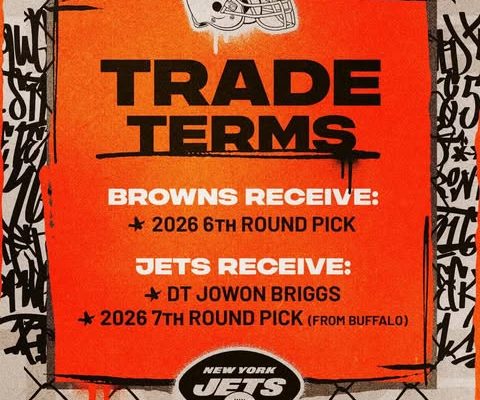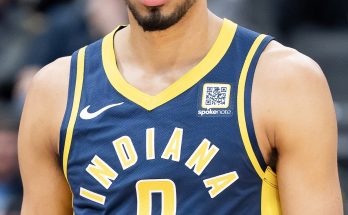The NFL offseason is often defined as much by the subtle, smaller trades and roster adjustments as it is by the blockbuster deals that dominate headlines. While the stars typically steal the spotlight, the moves involving rotational players and late-round draft picks can be just as important for shaping depth, balancing salary cap management, and preparing teams for the long grind of a season. Such is the case with the recent news that the Cleveland Browns have agreed to trade defensive tackle Jowon Briggs and a 2026 seventh-round pick to the New York Jets in exchange for a 2026 sixth-round pick. On the surface, the trade looks like a routine back-end roster transaction, but when you look deeper into the dynamics of the two franchises and their short- and long-term goals, the deal reveals a lot about where both the Browns and Jets stand heading into the next phase of their respective roster-building processes.
For Cleveland, moving Briggs in this way is less about immediate return and more about clearing a path for other players while maintaining flexibility in their draft capital. Briggs, who entered the league with potential but never quite carved out a consistent role in the Browns’ defensive line rotation, was stuck behind a crowded group of interior linemen. The Browns’ defensive front has been one of their stronger units, anchored by veterans and supplemented by younger players with higher upside. That depth made Briggs somewhat expendable, especially since his contributions had been limited to situational snaps. Rather than cutting ties outright and getting nothing in return, Cleveland was able to secure a minor upgrade in draft positioning. A 2026 sixth-round pick may not seem like a significant asset, but in a league where teams are constantly searching for cheap depth and hidden gems in the later rounds, moving up even one round can sometimes produce value. Late-round selections have historically produced players who blossom into important contributors, particularly in special teams or as developmental prospects.
From the Jets’ perspective, the deal makes sense as a low-risk, potentially high-reward maneuver. By acquiring Briggs along with a seventh-round pick in exchange for giving up only a sixth, New York essentially gets an extra player while sacrificing very little in terms of draft positioning. For a franchise that has been reshaping its defensive identity under head coach Robert Saleh, adding a versatile interior lineman who still has room to develop fits with their philosophy of building a deep and relentless defensive line rotation. Briggs is not expected to step in as a starter right away, but he could find a niche role in situational downs, particularly in run defense. With Saleh’s system emphasizing rotation, gap control, and physicality, Briggs will have an opportunity to prove himself in ways that he might not have been able to in Cleveland. The Jets’ defense has been one of the brighter spots for the team over the past couple of years, and adding another young body to the mix only strengthens their ability to remain fresh late in games.
What makes this trade particularly interesting is how it reflects the larger strategies at play for both organizations. The Browns are clearly in a phase where they are looking to consolidate and maximize their roster efficiency. Having invested heavily in certain positions, they need to ensure that they can continue to build around their core while keeping an eye on the future. For them, moving Briggs signals confidence in their current defensive line depth and a desire to accumulate draft capital in ways that may give them maneuverability in future trades or roster-building scenarios. For the Jets, meanwhile, this trade shows a willingness to take chances on young talent, even if that means absorbing players who may not have been fully developed elsewhere. In the modern NFL, where player development varies drastically depending on coaching, scheme, and opportunity, sometimes a change of scenery can unlock untapped potential.
It is also worth noting how late-round pick swaps like this reflect broader trends in NFL front office maneuvering. Teams are increasingly using these types of deals to effectively buy lottery tickets on players without spending significant assets. By flipping late-round picks, franchises are essentially hedging their bets: the cost is negligible, but the upside of hitting on a player who can fill a roster spot or contribute in rotational minutes can pay dividends. Briggs may or may not work out for the Jets, but even if he doesn’t, the real loss is minimal. Conversely, if he blossoms into a consistent depth piece or even a rotational starter, New York will have made an extremely efficient acquisition.
For Briggs himself, this move represents both a challenge and an opportunity. His time in Cleveland was marked by flashes of potential, but never quite enough consistency to secure him a regular role. Joining the Jets provides him with a fresh start, and sometimes that is all a player needs. Defensive tackle is one of the more physically demanding positions in the NFL, requiring not just size and strength but also technique, motor, and adaptability to different schemes. The Jets will undoubtedly be looking to test his ability to plug gaps in run defense, collapse the pocket on passing downs, and maintain discipline within their system. If Briggs can prove himself in training camp and preseason, he could earn himself a more stable role than he ever had in Cleveland.
The timing of this trade also speaks volumes. Both the Browns and the Jets are in different stages of contention, but both are operating under significant pressure. Cleveland is trying to maximize the prime of several key players while also proving that their roster-building strategy is sustainable in a highly competitive AFC. The Jets, on the other hand, are attempting to capitalize on their defensive strengths while also hoping to support an offense that has struggled with consistency and injuries. Adding depth to the defensive line is part of maintaining an identity as a team that wants to control games physically.
Fans often overlook smaller deals like this because they do not involve household names or immediate starters, but these transactions can be the difference between winning and losing games over the course of a long season. Depth in the trenches is one of the most important aspects of sustaining success in the NFL. Injuries, fatigue, and matchup adjustments all require a team to have more than just star players; they need role players who can step in and hold the line. If Briggs can provide that for the Jets, then this move will have been more than worth it.
In terms of draft capital, the value difference between a sixth- and seventh-round pick is marginal on paper, but NFL teams know that each incremental move up the board provides more options. For Cleveland, having that sixth-rounder may eventually be packaged in another trade, used to target a specific player, or simply turned into a camp body with upside. For New York, sliding down one round while gaining a player to evaluate is an acceptable cost. The calculus works for both sides, which is why this type of deal gets made frequently across the league.
There is also a psychological element to consider. For the Browns, moving Briggs may also send a message to the rest of the roster that competition is fierce and that spots must be earned. No one, not even a young developing lineman, is guaranteed a place if they do not consistently perform. For the Jets, acquiring him demonstrates to players that the front office is committed to exhausting every avenue to improve the team, no matter how small. These types of subtle cultural reinforcements can have long-term benefits in shaping locker room mentality and organizational identity.
Looking ahead, the true impact of this trade will be determined by Briggs’ ability to adapt and grow within the Jets’ system, as well as by what the Browns eventually do with the upgraded pick. If Briggs becomes a key rotation piece or even a reliable backup, then the Jets will have gotten tremendous value. If Cleveland turns the sixth-round pick into a player who contributes on special teams or develops into a depth piece themselves, then they will have extracted value from a situation where they had little leverage. Either way, this is the kind of deal that highlights the constant chess game being played by NFL front offices as they balance immediate needs, future flexibility, and roster development.
Ultimately, the trade of Jowon Briggs and a 2026 seventh-round pick from the Browns to the Jets in exchange for a 2026 sixth-round pick is not a headline-grabbing move, but it is a window into how teams operate behind the scenes. Every roster spot matters, every pick has potential value, and every decision is made with both short-term and long-term implications in mind. For fans, it may not move the needle in terms of excitement, but for coaches, scouts, and executives, deals like this are part of the lifeblood of building and sustaining a competitive team. In a league where the margin between winning and losing is razor-thin, sometimes it’s the quiet, under-the-radar moves that end up making the biggest difference.



